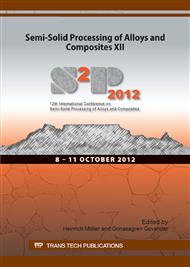p.197
p.204
p.209
p.215
p.219
p.225
p.231
p.238
p.246
Microstructure of Thixoformable Hypoeutectic Cast Iron
Abstract:
The use of a specially designed hypoeutectic cast iron as a potential raw material for the thixoforming process is described in this paper. Thixoforming technology normally uses aluminum-silicon alloys such A356 and A357 as raw materials. Iron-based alloys are less common, despite the lower cost of the raw material. The paper describes the semi-solid behavior and corresponding final microstructure of a hypoeutectic gray cast iron after thixoforming tests. The Fe-2.6wt%C-1.5wt%Si alloy was prepared via conventional casting in sand molds. Samples were heated to the semi-solid state at 1160 and 1180oC and held at these temperatures for 0, 30, 90 and 120s, and then subjected to compression tests. Two-platen compression tests were carried out in an instrumented eccentric press in order to determine the semi-solid behavior. The holding time in the semi-solid range simulates the industrial heating process that is time-controlled rather than temperature-controlled. The semi-solid behavior indicated that the semi-solid cast iron behaves like aluminum-silicon alloys, presenting a stress of up to 24MPa under 80% strain and a corresponding apparent viscosity of up to 1.5*105 Pa.s at 1180oC. The final microstructure after compression testing was essential in determining the material’s morphological evolution. Tests revealed that heating up to the semi-solid range followed by thixoforming changes the material’s graphite morphology from type A to B (or E), but does not significantly affect the interdendritic arm spacing between graphite lamellae. The resulting structure is composed of fine graphite and pearlite.
Info:
Periodical:
Pages:
219-224
Citation:
Online since:
October 2012
Price:
Сopyright:
© 2013 Trans Tech Publications Ltd. All Rights Reserved
Share:
Citation:


